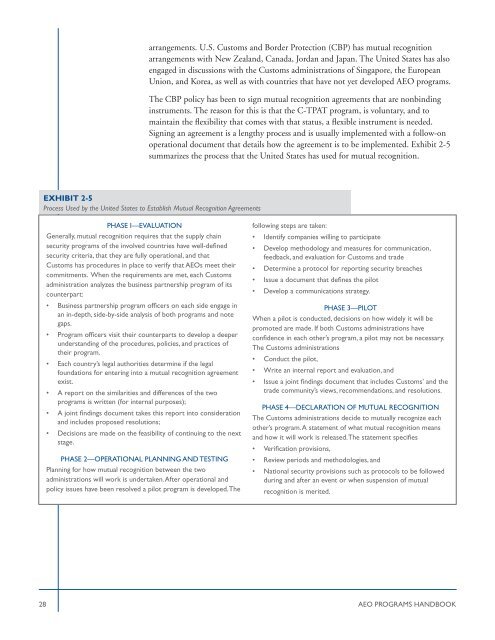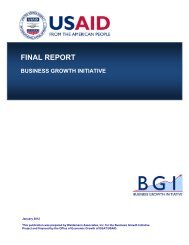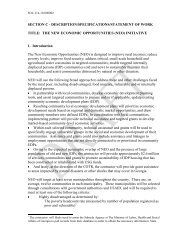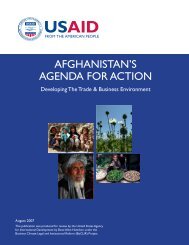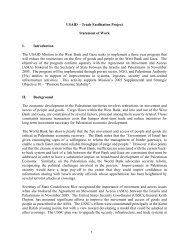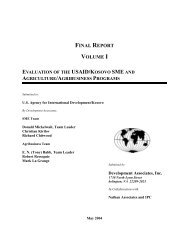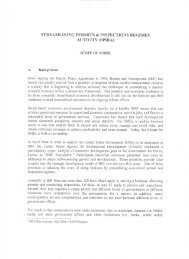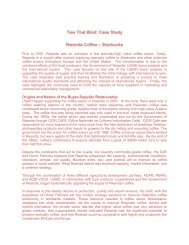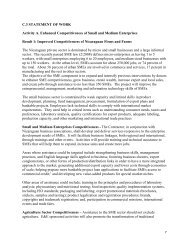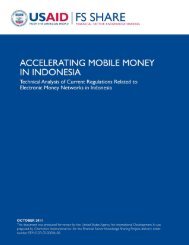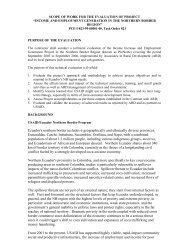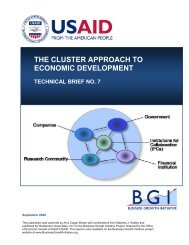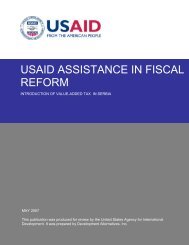authorized economic operator programs - Economic Growth - usaid
authorized economic operator programs - Economic Growth - usaid
authorized economic operator programs - Economic Growth - usaid
Create successful ePaper yourself
Turn your PDF publications into a flip-book with our unique Google optimized e-Paper software.
arrangements. U.S. Customs and Border Protection (CBP) has mutual recognition<br />
arrangements with New Zealand, Canada, Jordan and Japan. The United States has also<br />
engaged in discussions with the Customs administrations of Singapore, the European<br />
Union, and Korea, as well as with countries that have not yet developed AEO <strong>programs</strong>.<br />
The CBP policy has been to sign mutual recognition agreements that are nonbinding<br />
instruments. The reason for this is that the C-TPAT program, is voluntary, and to<br />
maintain the flexibility that comes with that status, a flexible instrument is needed.<br />
Signing an agreement is a lengthy process and is usually implemented with a follow-on<br />
operational document that details how the agreement is to be implemented. Exhibit 2-5<br />
summarizes the process that the United States has used for mutual recognition.<br />
EXHIBIT 2-5<br />
Process Used by the United States to Establish Mutual Recognition Agreements<br />
PHASE I—EVALUATION<br />
Generally, mutual recognition requires that the supply chain<br />
security <strong>programs</strong> of the involved countries have well-defined<br />
security criteria, that they are fully operational, and that<br />
Customs has procedures in place to verify that AEOs meet their<br />
commitments. When the requirements are met, each Customs<br />
administration analyzes the business partnership program of its<br />
counterpart:<br />
• Business partnership program officers on each side engage in<br />
an in-depth, side-by-side analysis of both <strong>programs</strong> and note<br />
gaps.<br />
• Program officers visit their counterparts to develop a deeper<br />
understanding of the procedures, policies, and practices of<br />
their program.<br />
• Each country’s legal authorities determine if the legal<br />
foundations for entering into a mutual recognition agreement<br />
exist.<br />
• A report on the similarities and differences of the two<br />
<strong>programs</strong> is written (for internal purposes);<br />
• A joint findings document takes this report into consideration<br />
and includes proposed resolutions;<br />
• Decisions are made on the feasibility of continuing to the next<br />
stage.<br />
PHASE 2—OPERATIONAL PLANNING AND TESTING<br />
Planning for how mutual recognition between the two<br />
administrations will work is undertaken. After operational and<br />
policy issues have been resolved a pilot program is developed. The<br />
following steps are taken:<br />
• Identify companies willing to participate<br />
• Develop methodology and measures for communication,<br />
feedback, and evaluation for Customs and trade<br />
• Determine a protocol for reporting security breaches<br />
• Issue a document that defines the pilot<br />
• Develop a communications strategy.<br />
PHASE 3—PILOT<br />
When a pilot is conducted, decisions on how widely it will be<br />
promoted are made. If both Customs administrations have<br />
confidence in each other’s program, a pilot may not be necessary.<br />
The Customs administrations<br />
• Conduct the pilot,<br />
• Write an internal report and evaluation, and<br />
• Issue a joint findings document that includes Customs’ and the<br />
trade community’s views, recommendations, and resolutions.<br />
PHASE 4—DECLARATION OF MUTUAL RECOGNITION<br />
The Customs administrations decide to mutually recognize each<br />
other’s program. A statement of what mutual recognition means<br />
and how it will work is released. The statement specifies<br />
• Verification provisions,<br />
• Review periods and methodologies, and<br />
• National security provisions such as protocols to be followed<br />
during and after an event or when suspension of mutual<br />
recognition is merited.<br />
28 AEO PROGRAMS HANDBOOK


